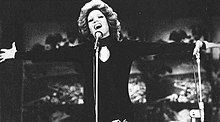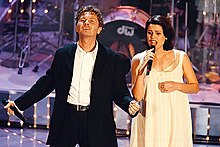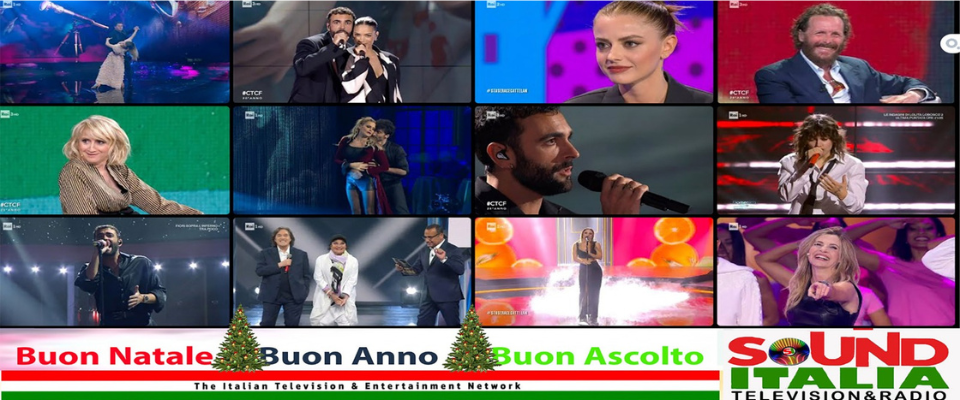
All about the Sanremo Music Festival – Known today as the “Sanremo SonFestival”
In the aftermath of World War II, one of the proposals to revitalize the economy and the reputation of Sanremo was to create an annual music festival to be held in the city.
In 1948 and 1949, the first two editions of the Italian Song Festival (Festival della Canzone Italiana) were held in Viareggio, from an idea developed in 1947 by Aldo Valleroni. The competition was discontinued in 1950 due to financial problems, but it became the basis for the future Sanremo Music Festival
During the summer of 1950, the administrator of the Sanremo Casino, Piero Bussetti, and the conductor of the RAI orchestra, Giulio Razzi, rediscussed the idea, deciding to launch a competition among previously unreleased songs. Officially titled Festival della Canzone Italiana (literally “Festival of the Italian song”), the first edition of the show was held at the Sanremo Casino on 29, 30, and 31 January 1951. The final round of the competition was broadcast by Rete Rossa, the second most important RAI radio station. Twenty songs took part in the competition, performed by three artists only–Nilla Pizzi, Duo Fasano, and Achille Togliani.
Starting from the third edition of the festival, held in 1953, each song was performed by two different artists with different orchestras and arrangements. Two years later, in 1955, the festival made its first appearance on television, since part of the final night was also broadcast by RAI’s channel Programma Nazionale. The last night of the show was also broadcast in Belgium, France, Germany, the Netherlands, and Switzerland.
In 1964, Gianni Ravera, who organized the 14th Sanremo Music Festival, slightly changed the rules of the contest, requiring each song to be performed once by an Italian artist and once by an international singer, who was allowed to perform the song in any language. The same rule was applied in the following year’s contest. Between 1967 and 1971, entries were not forced to be interpreted by foreign artists, but double performances were kept. Starting from 1972, each entry was sung by one artist only.

The competing artists were split for the first time into “Big artists” and “Young artists” during the Sanremo Music Festival 1974. The competition had one winner only, but the entries in the “Young artists” category had to go through an elimination round, while “Big artists” were directly admitted to the final round.
In 1977, the Sanremo Casino, which hosted all the previous editions of the contest, was closed for renovations, therefore the show moved to the Teatro Ariston. The theatre later became the usual location for the annual contest, hosting it every year except in 1990, when the show was held at the Nuovo Mercato dei Fiori, also known as Palafiori.
In 1980, pre-recorded backing tracks replaced the orchestra, while playback performances were allowed in 1983 during the final round. In 1984 and 1985, all the artists were forced to perform in playback, while live performances with the orchestra were reintroduced in 1990. During the same years, several other changes were introduced in the contest. In 1982, accredited music journalists decided to create an award to recognise the best song competing in the festival. Starting from 1983, the prize was officially awarded during the event. The Critics’ Prize was later named after Mia Martini, who was the first artist to receive it in 1982 for her entry “E non finisce mica il cielo”.
Moreover, starting in 1984, the separation between newcomers and established artists was marked, introducing two different competitions with separate winners. In 1989, a third category, the Upcoming Artists Section, was introduced, but it was removed the following year. Only in 1998 were the top three artists in the newcomer section allowed to compete in the main competition. This led to the victory of the debuting Annalisa Minetti, which generated some controversy and led to the reintroduction of completely separate competitions starting in 1999.
The distinction among different categories was abolished again in 2004. The following year, the contest included five different categories—Newcomers, Men, Women, Groups, and Classics. The winner of each category competed for the final victory of the contest. The category Classic was abolished in 2006 and starting in 2007, the festival came back to the rules used in the 1990s, with two completely separate competitions for established artists and newcomers.
In 2009, a new competition, held entirely online, was introduced by the artistic director of the 59th edition of the contest, Paolo Bonolis. Titled Sanremofestival.59, the contest was not held in the following years.
SO WHO WERE THE WINNERS!
| Year | Song | Artist(s) |
|---|---|---|
| 1951 | “Grazie dei fiori” (Saverio Seracini, Gian Carlo Testoni, Mario Panzeri) |
Nilla Pizzi |
| 1952 | “Vola colomba” (Carlo Concina, Bixio Cherubini) |
Nilla Pizzi |
| 1953 | “Viale d’autunno” (Giovanni D’Anzi) |
Carla Boni & Flo Sandon’s |
| 1954 | “Tutte le mamme” (Eduardo Falcocchio, Umberto Bertini) |
Giorgio Consolini & Gino Latilla |
| 1955 | “Buongiorno tristezza” (Mario Ruccione, Giuseppe Fiorelli) |
Claudio Villa & Tullio Pane |
| 1956 | “Aprite le finestre“ (Virgilio Panzuti, Giuseppe Perotti) |
Franca Raimondi |
| 1957 | “Corde della mia chitarra“ (Mario Ruccione, Giuseppe Fiorelli) |
Claudio Villa & Nunzio Gallo |
| 1958 | “Nel blu dipinto di blu“ (Domenico Modugno, Franco Migliacci) |
Domenico Modugno & Johnny Dorelli |
| 1959 | “Piove (Ciao, ciao bambina)“ (Domenico Modugno, Dino Verde) |
Domenico Modugno & Johnny Dorelli |
| Year | Song | Artist(s) |
|---|---|---|
| 1960 | “Romantica“ (Renato Rascel, Dino Verde) |
Tony Dallara & Renato Rascel |
| 1961 | “Al di là“ (Carlo Donida, Mogol) |
Betty Curtis & Luciano Tajoli |
| 1962 | “Addio, addio“ (Domenico Modugno, Franco Migliacci) |
Domenico Modugno & Claudio Villa |
| 1963 | “Uno per tutte“ (Tony Renis, Alberto Testa, Mogol) |
Tony Renis & Emilio Pericoli |
| 1964 | “Non ho l’età“ (Nicola Salerno, Mario Panzeri, Giancarlo Colonnello) |
Gigliola Cinquetti & Patricia Carli |
| 1965 | “Se piangi, se ridi“ (Gianny Marchetti, Bobby Solo, Mogol) |
Bobby Solo & The New Christy Minstrels |
| 1966 | “Dio, come ti amo“ (Domenico Modugno) |
Domenico Modugno & Gigliola Cinquetti |
| 1967 | “Non pensare a me” (Eros Sciorilli, Alberto Testa) |
Claudio Villa & Iva Zanicchi |
| 1968 | “Canzone per te“ (Sergio Endrigo, Luis Enriquez, Sergio Bardotti) |
Sergio Endrigo & Roberto Carlos |
| 1969 | “Zingara“ (Enrico Riccardi, Luigi Albertelli) |
Bobby Solo & Iva Zanicchi |
1970s



| Year | Song | Artist(s) |
|---|---|---|
| 1970 | “Chi non lavora non fa l’amore” (Adriano Celentano, Ferdinando De Luca, Luciano Beretta, Miki Del Prete) |
Adriano Celentano & Claudia Mori |
| 1971 | “Il cuore è uno zingaro“ (Claudio Mattone, Franco Migliacci) |
Nada & Nicola Di Bari |
| 1972 | “I giorni dell’arcobaleno“ (Nicola Di Bari, Piero Pintucci, Dalmazio Masini) |
Nicola Di Bari |
| 1973 | “Un grande amore e niente più” (Peppino Di Capri, Claudio Mattone, Gianni Wright, Giuseppe Faiella, Franco Califano) |
Peppino Di Capri |
| 1974 | “Ciao cara, come stai?” (Cristiano Malgioglio, Italo Ianne, Claudio Fontana, Antonio Ansoldi) |
Iva Zanicchi |
| 1975 | “Ragazza del sud” (Rosangela Scalabrino) |
Gilda |
| 1976 | “Non lo faccio più” (Salvatore De Pasquale, Fabrizio Berlincioni, Salvatore De Pasquale, Sergio Iodice) |
Peppino Di Capri |
| 1977 | “Bella da morire” (Renato Pareti, Alberto Salerno) |
Homo Sapiens |
| 1978 | “…e dirsi ciao“ (Piero Cassano, Carlo Marrale, Antonella Ruggiero, Salvatore Stellitta, Giancarlo Golzi) |
Matia Bazar |
| 1979 | “Amare” (Sergio Ortone, Piero Soffici, Pietro Finà) |
Mino Vergnaghi |
1980s



| Year | Song | Artist(s) |
|---|---|---|
| 1980 | “Solo noi“ (Toto Cutugno) |
Toto Cutugno |
| 1981 | “Per Elisa“ (Franco Battiato, Giusto Pio, Alice Visconti) |
Alice |
| 1982 | “Storie di tutti i giorni“ (Riccardo Fogli, Maurizio Fabrizio, Guido Morra) |
Riccardo Fogli |
| 1983 | “Sarà quel che sarà” (Maurizio Fabrizio, Roberto Ferri) |
Tiziana Rivale |
| 1984 | “Ci sarà“ (Dario Farina, Cristiano Minellono) |
Al Bano & Romina Power |
| 1985 | “Se m’innamoro“ (Dario Farina, Cristiano Minellono) |
Ricchi e Poveri |
| 1986 | “Adesso tu“ (Eros Ramazzotti, Piero Cassano, Adelio Cogliati) |
Eros Ramazzotti |
| 1987 | “Si può dare di più“ (Umberto Tozzi, Giancarlo Bigazzi, Raffaele Riefoli) |
Gianni Morandi, Enrico Ruggeri & Umberto Tozzi |
| 1988 | “Perdere l’amore“ (Marcello Marrocchi, Giampiero Artegiani) |
Massimo Ranieri |
| 1989 | “Ti lascerò“ (Franco Fasano, Fausto Leali, Franco Ciani, Fabrizio Berlincioni, Sergio Bardotti) |
Anna Oxa & Fausto Leali |
1990s


| Year | Song | Artist(s) |
|---|---|---|
| 1990 | “Uomini soli“ (Valerio Negrini, Roby Facchinetti) |
Pooh & Dee Dee Bridgewater |
| 1991 | “Se stiamo insieme” (Riccardo Cocciante, Mogol) |
Riccardo Cocciante |
| 1992 | “Portami a ballare“ (Luca Barbarossa) |
Luca Barbarossa |
| 1993 | “Mistero” (Enrico Ruggeri) |
Enrico Ruggeri |
| 1994 | “Passerà” (Aleandro Baldi) |
Aleandro Baldi |
| 1995 | “Come saprei“ (Eros Ramazzotti, Vladimiro Tosetto, Adelio Cogliati, Giorgia Todrani) |
Giorgia |
| 1996 | “Vorrei incontrarti fra cent’anni” (Rosalino Cellamare) |
Ron with Tosca |
| 1997 | “Fiumi di parole“ (Fabio Ricci, Alessandra Drusian, Carmela Di Domenico) |
Jalisse |
| 1998 | “Senza te o con te” (Massimo Luca, Paola Palma) |
Annalisa Minetti |
| 1999 | “Senza pietà” (Alberto Salerno, Claudio Guidetti) |
Anna Oxa |
2000s

| Year | Song | Artist(s) |
|---|---|---|
| 2000 | “Sentimento“ (Fausto Mesolella, Giuseppe D’Argenzio, Ferruccio Spinetti, Domenico Ciaramella, Giuseppe Servillo) |
Piccola Orchestra Avion Travel |
| 2001 | “Luce (Tramonti a nord est)“ (Elisa Toffoli, Adelmo Fornaciari) |
Elisa |
| 2002 | “Messaggio d’amore” (Giancarlo Golzi, Piero Cassano) |
Matia Bazar |
| 2003 | “Per dire di no“ (Alberto Salerno, Alessia Aquilani) |
Alexia |
| 2004 | “L’uomo volante“ (Marco Masini) |
Marco Masini |
| 2005 | “Angelo” (Francesco Renga, Maurizio Zapatini) |
Francesco Renga |
| 2006 | “Vorrei avere il becco” (Giuseppe Povia) |
Povia |
| 2007 | “Ti regalerò una rosa“ (Simone Cristicchi) |
Simone Cristicchi |
| 2008 | “Colpo di fulmine“ (Gianna Nannini) |
Giò Di Tonno & Lola Ponce |
| 2009 | “La forza mia” (Paolo Carta) |
Marco Carta |
2010s


| Year | Song | Artist(s) |
|---|---|---|
| 2010 | “Per tutte le volte che…” (Pierdavide Carone) |
Valerio Scanu |
| 2011 | “Chiamami ancora amore“ (Roberto Vecchioni, Claudio Guidetti) |
Roberto Vecchioni |
| 2012 | “Non è l’inferno“ (Francesco Silvestre, Enrico Palmosi, Luca Sala) |
Emma |
| 2013 | “L’essenziale“ (Marco Mengoni, Roberto Casalino, Francesco De Benedittis) |
Marco Mengoni |
| 2014 | “Controvento“ (Giuseppe Anastasi) |
Arisa |
| 2015 | “Grande amore“ (Francesco Boccia, Ciro Esposito) |
Il Volo |
| 2016 | “Un giorno mi dirai“ (Saverio Grandi, Gaetano Curreri, Luca Chiaravalli) |
Stadio |
| 2017 | “Occidentali’s Karma“ (Francesco Gabbani, Filippo Gabbani, Fabio Ilacqua, Luca Chiaravalli) |
Francesco Gabbani |
| 2018 | “Non mi avete fatto niente“ (Ermal Meta, Fabrizio Moro, Andrea Febo) |
Ermal Meta & Fabrizio Moro |
| 2019 | “Soldi“ (Mahmood, Dardust, Charlie Charles) |
Mahmood |
2020s

| Year | Song | Artist(s) |
|---|---|---|
| 2020 | “Fai rumore“ (Diodato, Edwyn Roberts) |
Diodato |
| 2021 | “Zitti e buoni“ (Damiano David, Ethan Torchio, Thomas Raggi, Victoria De Angelis) |
Måneskin |
| 2022 | “Brividi“ (Alessandro Mahmoud, Riccardo Fabbriconi, Michele Zocca) |
Mahmood & Blanco |
| 2023 | “Due vite“ (Davide Petrella, Davide Simonetta, Marco Mengoni) |
Marco Mengoni |
| 2024 | TBD 10 February 2024 | |
.
Festival della canzone italiana di Sanremo, has been held every year since 1951





